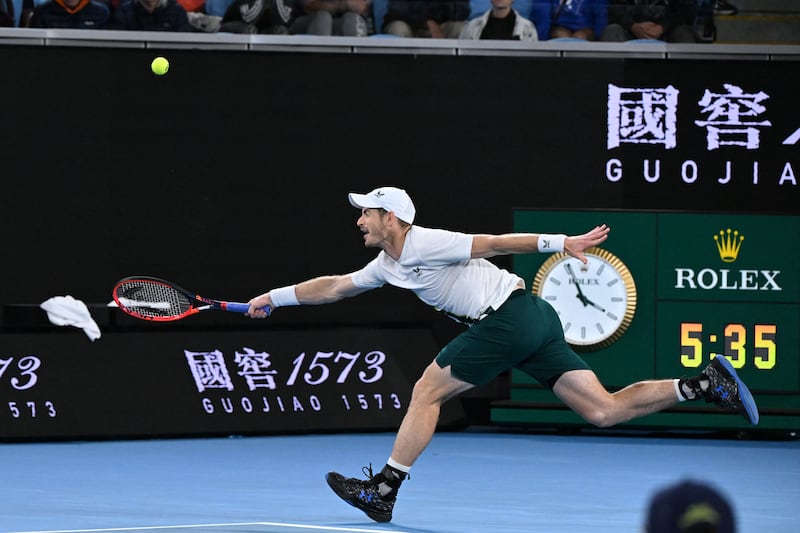She started out with five shots of local anaesthetic, pinned and then pressed evenly into and around my left kneecap. She then pried her way through, cutting across softly at first, through the thin yet tough fibrous sheets which lie below. Still averting my gaze, feeling nothing other than being in her safe surgeon hands, so the entire process went about with immaculate precision.
Then she was done, any remnants of the bloody operation taken away as if leftovers from a pizza joint, and after the final cleansing and anointing the kneecap was covered again with a large Band-Aid and some gauze strapping over what later felt like a gunshot wound.
[ Andy Murray toils past Thanasi Kokkinakis in near-six-hour marathon matchOpens in new window ]
Fear not the obvious. This wasn’t the inevitable result of decades of distance running, over a half century now if you believe we were born for it, nothing whatsoever to do with wear or tear or grinding around the knee or anywhere else for that matter. Which is mostly nonsense to begin with.
It was the result of a stubborn old skin cyst, just under that left kneecap, gently grazed on some coral in Barbados last month, savagely infected some time later, and so promptly addressed last week, leaving no damage other than return trips to the VHI Clinic in Carrickmines every second morning to clean and redress the wound until that magic skin tissue which protects against all seasons returns.
READ MORE
Of all the popular myths about the distance runner – that we’re a lonely breed, enemies of pleasure and friends of pain, positively mad – is that myth we all end up half-crippled from somewhere around the hips or knees down, such is our damning and damaging pursuit.
It is true that our bones, all 208 of them – our blood factories, our own secret suppliers of EPO – must be let rest, for the calcium to flow, to stay tooled and tightened and aligned: what simply isn’t true is that distance running does irreparable damage to the bones around the hips or knees, when more often it does the opposite.
This myth persists despite study after study (look them up on Yahoo) indicating distance running rarely causes or exacerbates any injuries to the knee, including any onset of arthritis; instead, running strengthens all the main leg muscles supporting the knees, allowing them to take on and offload more of the strains involved in repeatedly striking the ground.
Trust me and my knees, once adopting any sensibly correct style, and remember the golden rules – running with the legs, not on them, weight shifted to the upper body, hips forward as if in the moment of deepest penetration – there will always be miles to run and promises to keep.

There are natural differences between impact sport and contact sport, even if the lines sometimes get blurred, with different repercussions entirely. Especially around the knee, and those preciously thin cruciate ligaments which criss-cross the meniscus, right where the femur is introduced to the tibia by the patella, the tearing of which requires not minor surgery.
If, however, tennis is considered an impact and not contact sport then the achievement of Andy Murray on the Melbourne courts this week is out there in a category of its own, one of the ultimate back from the breaks, an incredible resurfacing after an assault on the bone which would surely have ended the career of any lesser athlete.
Four years ago, this very same week, Murray was being written off by many as done for, by myself included, after he lost his first round match of the Australian Open to Roberto Bautista Agut, the Spaniard winning after a four-hour, five-set epic. Then aged 31, Murray had already required one hip operation, in early 2018, such was the unbearable pain resulting from the at times violently athletic movements and wear and tear on the tennis court.
Once the hip of any elite athlete goes under the surgeon’s knife it’s rarely the same, only Murray required a second operation shortly after that 2019 Australian Open defeat, opting not for the full hip replacement which some said he necessitated, but the hip resurfacing surgery, which involved a cobalt-chrome metal cap being placed over the femur with a matching metal cup in the acetabulum, our rounded hip bone socket.
Some of this procedure is captured in Resurfacing, the 2019 documentary tracing the relentless pursuit of his comeback, which opens with the three-time Grand Slam winner, two-time Olympic champion, saying; “I was the number one tennis player in the world, and I couldn’t walk ...”
Afterwards his esteemed surgeon Sarah Muirhead-Allwood, who had previously operated on the Queen Mother, tells him: “What if I said, if you went back to playing first-class tennis, I think you’ve got a 15 per cent chance that in the first seven years you could destroy the hip.”
To which Murray nervously replies: “That is what it is like, it’s not it will or it won’t. It is chances. For seven years of tennis would you take that risk?”
Murray was willing and turns out more than able, winning a singles match on tour just six months later. Before this week, four months shy of turning 36, the Scottish player twice laughed in the face of all those who doubted him, firstly by saving a match point against Matteo Berrettini in round one, the Italian 10 years his junior, a five-setter which lasted four hours and 49 minutes, before Murray prevailed in a 10-point match tie-break.
Then, in Thursday’s second-round showdown against Australia’s Thanasi Kokkinakis, Murray displayed powers of body and mind rarely witnessed in any sport, winning this time the longest match of his career, another crazy five-setter lasting five hours and 45 minutes and ending at 4.0am local time. Then straight to the bathroom!
You don’t have to be an elite athlete or esteemed surgeon to respect all that, two ultra-marathons of a tennis match, or indeed where it leaves Murray now, playing Roberto Bautista Agut again, for a place in the fourth round, four years on.
Others have come back against similar odds, the front lines of surgical theatres, such as Tiger Woods winning the 2019 Masters, aged 43, even if golf doesn’t touch the physicality of tennis. Because whatever about this myth of distance running damaging the hips and knees, what Murray has medically and physically defied on the tennis court is the stuff of legend.

















